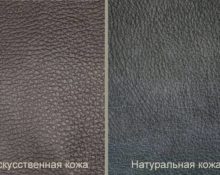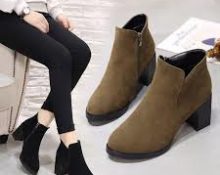The demand for vegan leather substitutes is increasing every year. This is probably why vegan leather has become a real super trend! Launched at New York Fashion Week, the vegan suede used in Stella McCartney's designs was spectacular!

Reference. The designer has been working for years on innovative fabrics that will forever replace fur, kid, and wool and at the same time be environmentally friendly.
Similarities and differences with traditional leather
Eco-leather is increasingly used in the production of clothing, shoes and furniture. But how does it differ from natural?

Natural leather comes from the skin of animals, mainly cows (but poor crocodiles and pythons are also in danger). Its production is associated with the death of killed animals (which many people do not think about). This the material is very durable, provides adequate moisture circulation.
Vegan leather (otherwise known as faux leather) is made from a material that imitates natural leather.. Actually made of polyester fabric, additionally coated with polyvinyl chloride.During production it is subjected to chemical processes.
Although both materials are similar, they are easy to differentiate.
- First of all, pay attention to the label. It should contain information about whether the product was created from natural or synthetic materials.
- Smell can also help differentiate materials. Natural leather has a specific odor, while synthetic leather is usually odorless.
- Texture faux leather looks the same because it is mass produced. Natural ones have heterogeneous cavities.
What is vegan leather made from?
Everyone considers vegan leather artificial, and indeed, when its production began in the 70s, the raw material was polyvinyl chloride. But it is dangerous to health and fragile!

Important! Today, the basis of new materials is polyurethane (it is safer to use). But the most interesting thing is that natural products are also involved in the production of new skin.
Synthetic materials
The type of polymer used varies.
- Polyurethane The material is completely breathable, so the problem of sweaty feet in shoes is eliminated. Moreover, it is much less toxic to produce than other options. Of course, the environmental impact of this material depends on the regulations of the country in which it is produced.
- Freedom Leather uses a patented, environmentally friendly formula to create an alternative to traditional styles. What makes Freedom Leather unique is that it is made Made from 100% silicone, which does not contain plastic or petroleum.
Important! This fabric is prized for its durability and consistent quality. It is environmentally friendly, and its production requires less consumption of water, raw materials and electricity, compared to the production of PU and PVC fabrics.
This makes her safer and healthier for people.
However, it is too early to call eco-leather production non-toxic. Fortunately, textile scientists are working on this issue, developing new types to make them more environmentally friendly. One of the latest innovations is use of plant-based plastics, which completely reduces the risk associated with the production of conventional polyurethane.
Natural materials

Have you heard of the material Piñatex™, created by Carmen Hijosa? For many years she was looking for an alternative to natural materials. In search of something innovative, I visited many countries and ended up in the Philippines. Here the search for new natural fibers began. Her breakthrough came when she realized she could create material without weaving or knitting process, compact, ready for further processing. And most importantly, from the material available locally. Currently pineapple peel tested by brands such as Puma or Camper.
MuSkin created especially for vegans - 100% biodegradable, made from a mushroom cap and colored without any chemicals. Breathable, waterproof, non-toxic to human skin. Who would have thought!
MYX - natural material obtained from fungal spores and plant fibers. The product was invented by Danish designer Jonas Edward. He focused on using household waste and the ability of oysters to extract cellulose from the plant along with enzymes.
And a wonderful idea came up - to make leather from tea! Young-A Lee and a team of designers created a prototype shoe and vest made from cellulose fibers, a byproduct of the tea brewing process. Kombucha.
Important! This substitute is 100% biodegradable and completes the natural zero waste cycle.Unfortunately, the product is not perfect (when the material gets wet, it becomes less durable).
Research into its functionality is still ongoing.
Advantages and disadvantages of vegan leather

Cruelty to animals aside, we still ask the same question: is vegan leather good for the health and well-being of children? To understand this, let’s note the pros and cons of the material.
Advantages
- Faux leather cheaper.
- It does not require special care.
- Much easierthan natural.
- Easy to clean.
Attention! Natural materials quickly deteriorate, which means they no longer look beautiful and perform their function.
Flaws
- Eco-leather is made from air-tight materials. This may cause excessive sweating or irritation.
- Unlike natural not completely biodegradable.
- There are many aspects to every step of the production of vegan or faux leather shoes that cause serious harm to both people and the environment.
Prospects
New fashion market research conducted by consultancy Grand View Research has found that The artificial leather industry will be worth $85 billion by 2025..
It turned out that in countries that still produced natural leather on a huge scale (China, Brazil, Thailand, Malaysia, Vietnam), Demand for plant substitutes will increase due to interest in inexpensive footwear.


 0
0





